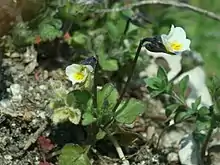| Viola kitaibeliana | |
|---|---|
 | |
| Scientific classification | |
| Kingdom: | Plantae |
| Clade: | Tracheophytes |
| Clade: | Angiosperms |
| Clade: | Eudicots |
| Clade: | Rosids |
| Order: | Malpighiales |
| Family: | Violaceae |
| Genus: | Viola |
| Species: | V. kitaibeliana |
| Binomial name | |
| Viola kitaibeliana | |
| Synonyms[2] | |
| |
Viola kitaibeliana, the dwarf violet, is a plant species in the genus Viola. It is native to a large area from the Canary Islands, across Europe, to northern Iran and southern Turkmenistan.[2]
It is an annual, and requires disturbed or grazed soil to grow.[3]
In 2021, two plants were discovered flowering on the 0.16 sq km island of Teän, in the Scilly Isles; the first seen there for 16 years.[3]
Taxonomy
Besides the nominate taxon, there are two other infraspecific taxa which are recognised in Plants of the World Online as of 2017:[2]
- Viola kitaibeliana subsp. kitaibeliana
- Viola kitaibeliana subsp. machadiana (Cout.) Capelo & C.Aguiar
- Viola kitaibeliana subsp. trimestris (DC. ex Ging.) Espeut
Description
This herbaceous plant is not higher than 12 cm. Like all violets the flowers are zygomorphic.
References
- ↑ "Viola kitaibeliana". International Plant Names Index. The Royal Botanic Gardens, Kew, Harvard University Herbaria & Libraries and Australian National Botanic Gardens. Retrieved 27 October 2020.
- 1 2 3 "Viola kitaibeliana Schult". Plants of the World Online. Royal Botanic Gardens, Kew. 2017. Retrieved 27 October 2020.
- 1 2 Barkham, Patrick (2021-05-29). "Dwarf pansy blooms on tiny Scilly island after 16-year absence". The Guardian. Retrieved 29 May 2021.
This article is issued from Wikipedia. The text is licensed under Creative Commons - Attribution - Sharealike. Additional terms may apply for the media files.